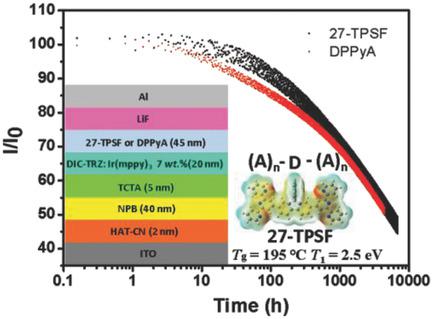当前位置:
X-MOL 学术
›
Adv. Funct. Mater.
›
论文详情
Our official English website, www.x-mol.net, welcomes your feedback! (Note: you will need to create a separate account there.)
Long‐Lived and Highly Efficient TADF‐PhOLED with “(A)n–D–(A)n” Structured Terpyridine Electron‐Transporting Material
Advanced Functional Materials ( IF 19.0 ) Pub Date : 2018-05-02 , DOI: 10.1002/adfm.201800429 Mengying Bian 1 , Dongdong Zhang 2 , Yuanxun Wang 3 , Yao-Hsien Chung 1 , Yang Liu 4 , Hungkit Ting 1 , Lian Duan 2 , Zhijian Chen 1 , Zuqiang Bian 4 , Zhiwei Liu 4 , Lixin Xiao 1, 5
Advanced Functional Materials ( IF 19.0 ) Pub Date : 2018-05-02 , DOI: 10.1002/adfm.201800429 Mengying Bian 1 , Dongdong Zhang 2 , Yuanxun Wang 3 , Yao-Hsien Chung 1 , Yang Liu 4 , Hungkit Ting 1 , Lian Duan 2 , Zhijian Chen 1 , Zuqiang Bian 4 , Zhiwei Liu 4 , Lixin Xiao 1, 5
Affiliation

|
The electron‐transporting material (ETM) is one of the key factors to determine the efficiency and stability of organic light‐emitting diodes (OLEDs). A novel ETM with a “(Acceptor)n–Donor–(Acceptor)n” (“(A)n–D–(A)n”) structure, 2,7‐di([2,2′:6′,2″‐terpyridin]‐4′‐yl)‐9,9′‐spirobifluorene (27‐TPSF), is synthesized by combining electron‐withdrawing terpyridine (TPY) moieties and rigid twisted spirobifluorene, in which the TPY moieties facilitate electron transport and injection while the spirobifluorene moiety ensures high triplet energy (T1 = 2.5 eV) as well as enhances glass transition temperature (Tg = 195 °C) for better stability. By using tris[2‐(p‐tolyl)pyridine]iridium(III) (Ir(mppy)3) as the emitter, the 27‐TPSF‐based device exhibits a maximum external quantum efficiency (ηext, max) of 24.5%, and a half‐life (T50) of 121, 6804, and 382 636 h at an initial luminance of 10 000, 1000, and 100 cd m−2, respectively, which are much better than the commercialized ETM of 9,10‐bis(6‐phenylpyridin‐3‐yl)anthracene (DPPyA). Furthermore, a higher efficiency, a ηext, max of 28.2% and a maximum power efficiency (ηPE, max) of 129.3 lm W−1, can be achieved by adopting bis(2‐phenylpyridine)iridium(III)(2,2,6,6‐tetramethylheptane‐3,5‐diketonate) (Ir(ppy)2tmd) as the emitter and 27‐TPSF as the ETM. These results indicate that the derivative of TPY to form “(A)n–D–(A)n” structure is a promising way to design an ETM with good comprehensive properties for OLEDs.
中文翻译:

具有“(A)n–D–(A)n”结构的联吡啶电子传输材料的长寿命高效TADF-PhOLED
电子传输材料(ETM)是确定有机发光二极管(OLED)的效率和稳定性的关键因素之一。一种新颖的ETM与“(受体)ñ -Donor-(受体)ñ ”(“(A)ñ -D-(A)ñ ”)结构,2,7-二([2,2':6', 2”-三联吡啶] -4'-基)-9,9'-螺二芴(27-TPSF)是通过结合吸电子的吡啶(TPY)部分和刚性扭曲的螺二芴而合成的,其中TPY部分促进了电子的传输和螺二芴部分可确保高三重态能量(T 1 = 2.5 eV)并提高玻璃化转变温度(T g = 195°C),以获得更好的稳定性。通过使用tris [2-基于对甲苯基]吡啶]铱(III)(Ir(mppy)3)的发射器,基于27-TPSF的器件具有24.5%的最大外部量子效率(ηext ,max),半衰期为(121、6804和382636h的T 50)在初始亮度分别为10000、1000和100 cd m -2时要好于9,10-bis(6-苯基吡啶-)的商业化ETM。 3-基)蒽(DPPyA)。此外,更高的效率,η一个分机,最大值28.2%和最大功率效率(η PE,最大值129.3流明)W,-1,可通过采用双(2-苯基吡啶)铱(III)(2来实现, 2,6,6-四甲基庚烷-3,5-二酮酸酯)(Ir(ppy)2tmd)作为发射器,而27-TPSF作为ETM。这些结果表明,TPY衍生物形成“(A)n –D–(A)n ”结构是设计具有良好综合性能的OLED ETM的有前途的方法。
更新日期:2018-05-02
中文翻译:

具有“(A)n–D–(A)n”结构的联吡啶电子传输材料的长寿命高效TADF-PhOLED
电子传输材料(ETM)是确定有机发光二极管(OLED)的效率和稳定性的关键因素之一。一种新颖的ETM与“(受体)ñ -Donor-(受体)ñ ”(“(A)ñ -D-(A)ñ ”)结构,2,7-二([2,2':6', 2”-三联吡啶] -4'-基)-9,9'-螺二芴(27-TPSF)是通过结合吸电子的吡啶(TPY)部分和刚性扭曲的螺二芴而合成的,其中TPY部分促进了电子的传输和螺二芴部分可确保高三重态能量(T 1 = 2.5 eV)并提高玻璃化转变温度(T g = 195°C),以获得更好的稳定性。通过使用tris [2-基于对甲苯基]吡啶]铱(III)(Ir(mppy)3)的发射器,基于27-TPSF的器件具有24.5%的最大外部量子效率(ηext ,max),半衰期为(121、6804和382636h的T 50)在初始亮度分别为10000、1000和100 cd m -2时要好于9,10-bis(6-苯基吡啶-)的商业化ETM。 3-基)蒽(DPPyA)。此外,更高的效率,η一个分机,最大值28.2%和最大功率效率(η PE,最大值129.3流明)W,-1,可通过采用双(2-苯基吡啶)铱(III)(2来实现, 2,6,6-四甲基庚烷-3,5-二酮酸酯)(Ir(ppy)2tmd)作为发射器,而27-TPSF作为ETM。这些结果表明,TPY衍生物形成“(A)n –D–(A)n ”结构是设计具有良好综合性能的OLED ETM的有前途的方法。



























 京公网安备 11010802027423号
京公网安备 11010802027423号